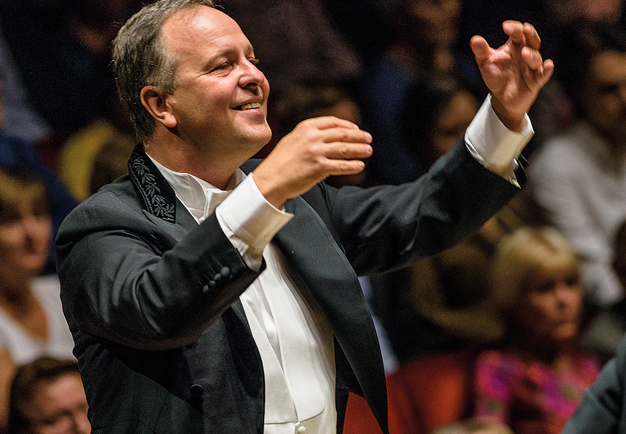Symphony No. 3

Sakari Oramo conducts the third symphony on May 22
Is there religious content and hidden messages in the third symphony?
Jean Sibelius’ Symphony No. 3 is the work that the Royal Stockholm Philharmonic Orchestra has performed the least: 20 times (+ 4 radio performances). The first time the Royal Stockholm Philharmonic Orchestra performed Symphony No. 3 was on 21 January 1919, with Wilhelm Stenhammar conducting. Symphony No. 3 was also performed by the Royal Stockholm Philharmonic Orchestra on the occasion of the composer’s 70th birthday on 4 December 1935, conducted by Georg Schnéevoigt.
Jean Sibelius
Symphony No. 3 C major op 52 (1907)
Allegro moderato
Andantino con moto, quasi allegretto
Moderato. Allegro (ma non tanto)
Duration approx. 30 minutes
If the first two symphonies by Sibelius can more or less be described as National Romantic, the third frustrates all attempts at categorization. It is definitely a bridge work. Most who comment on the symphony have observed that there is a tendency towards a sort of classicism. It is most likely the first movement (Allegro moderato), orchestrated with a sure and natural grace, that supplies the reasoning behind this characterization. The form of the movement is almost an orthodox sonata-allegro with an exposition, development, recapitulation, and coda, even if it is difficult to say exactly where one section ends and another begins. The development seems to start as soon as in the exposition, and continue on into the recapitulation. What sticks out are perpetual motion motives; form-defining cadences are few.
The second movement (Andantino con moto, quasi Allegretto), with its simple theme that associates to folk music, does not diminish the impression given by the first movement. The third movement (Moderato. Allegro ma non tanto), on the other hand, does not appear to fit into the picture. The form is difficult to comprehend and leaves several questions unanswered. Most often, the movement has been interpreted as a mix of a scherzo and finale: it begins as a scherzo and ends with a hymn-like nobility in variation form, where the mysterious coda from the first movement suddenly becomes understandable. But formal analysis alone does not explain the singular distinctiveness of this symphony, which differs markedly from his previous two.
The first ideas for the symphony appeared in 1904. In September of that year, Sibelius writes to his friend Axel Carpelan: ”I have begun work on my Third symphony!” But the real work on the piece first gained momentum at the end of 1906: ”… now I must put all my energy towards the Third symphony– my entire soul is filled by it,” he wrote to his publisher Robert Lienau on December 21. And in July the symphony was ”almost finished.” The third movement was however not completed until just a few days before the premiere on September 25, 1907, under the direction of the composer himself.
Sketches show that Sibelius worked on several pieces at the same time, each in its own stage of development. When he worked most intensively on the Third symphony, he had just completed Pohjola’s daughter, op 49 (1906), but left two other projects, Luonnotar and Marjatta, unfinished. Luonnotar was a symphonic poem or fantasy about the creation myth as told in the first poem of Kalevala (not to be confused with Luonnotar op 70, symphonic poem for soprano and orchestra from 1913). Marjatta was an oratorio. The writer Jalmari Finne had offered Sibelius a libretto based on the Marjatta legend in Kalevala. The legend, told in the 30th poem of the epos, is about the birth of Christ. The virgin Marjatta goes into the forest, eats a lingonberry, becomes pregnant, and gives birth to a boy, who when he is baptized sends Väinämöinen out to the open sea. The heathen era gives way to Christianity.
Sibelius wrote quite a lot of music for both Luonnotar and Marjatta before he abandoned the projects. Some of the music came to be used in Pohjola’s daughter, and some in the Third symphony. At one point this is especially clear: the chorale-like section in the second movement of the symphony is taken from the Luonnotar project.
The relationship to Marjatta is more speculative, but there are reasons to believe that the religious content in the oratorio is somehow also mirrored in the Third symphony. It has for example been pointed out that there are exceptionally many psalm and chorale-like parts in the Third symphony that can be found in all three movements. There might also be a hidden message in the fact that the symphony has three movements. It is in no way proven, nor however has it been ruled out, that the movements correspond to Christ’s birth, burial, and resurrection, taken from the libretto of Marjatta.
— Ilkka Oramo
English translation: George Kentros
